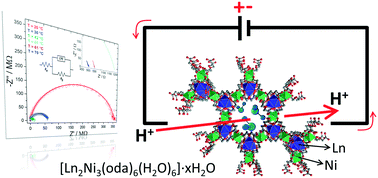Ln(iii)–Ni(ii) heteropolynuclear metal organic frameworks of oxydiacetate with promising proton-conductive properties†
Abstract
Heteropolynuclear metal organic frameworks (MOFs) of the general formula [Ln2Ni3(oda)6(H2O)6]·xH2O (oda = oxydiacetate, Ln = +3 rare earth ion) were synthesized and characterized. Most of them bear a honeycomb structure with 1D channels containing 11 to 14 crystallization water molecules per formula unit. The size of the channels and the number of crystallization water molecules they contain decrease as the Ln ionic radii become smaller along the series from La to Tm. In addition, the water content changes reversibly with temperature and relative humidity conditions. Accordingly, the as-synthesized [Tm2Ni3(oda)6(H2O)6]·11H2O picks up water when exposed to a 100% relative humidity atmosphere to become [Tm2Ni3(oda)6(H2O)6]·14H2O. Computational calculations show the formation of a hydrogen bond network in which layers of water molecules are arranged and associated primarily to the polar groups of the framework walls, anticipating good proton conduction along the [001] channels. Furthermore, higher confinement of water molecules in the smaller channels could favor the water molecules' mobility. Indeed, the proton conductivity of [Tm2Ni3(oda)6(H2O)6]·14H2O is 2.43 × 10−3 S cm−1 at 70 °C, similar to that of standard conductive MOF-based materials reported. A vehicular carrier mechanism by means of H3O+ species diffusing along the 1D channels of the porous structure seems to be operative, with a high activation energy value of 1.46 eV.



 Please wait while we load your content...
Please wait while we load your content...